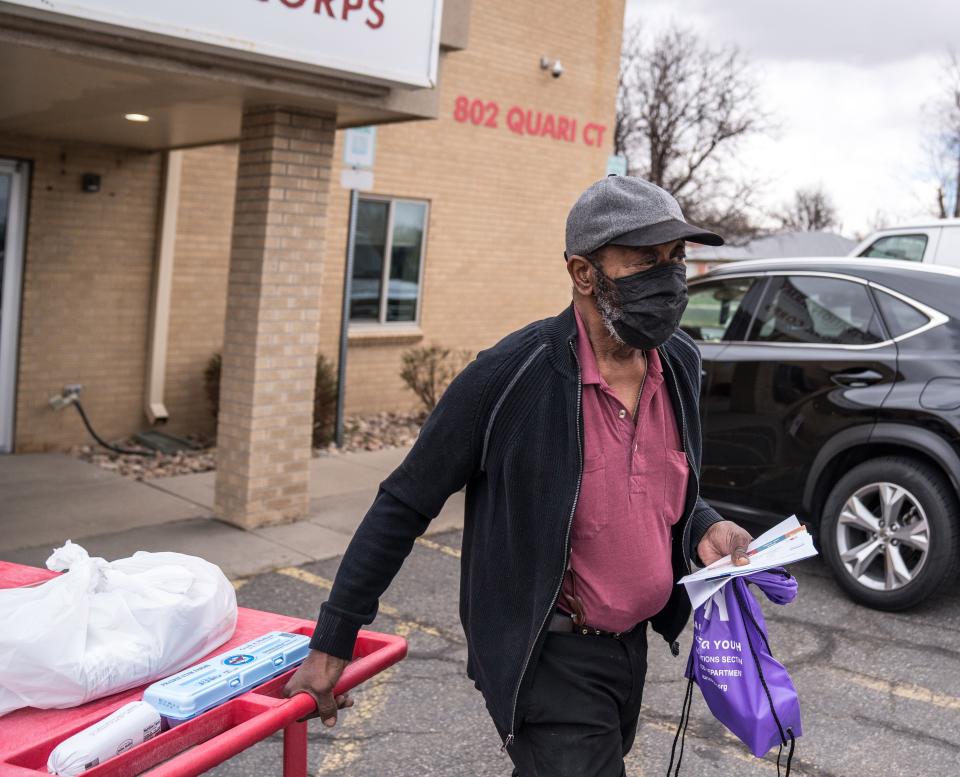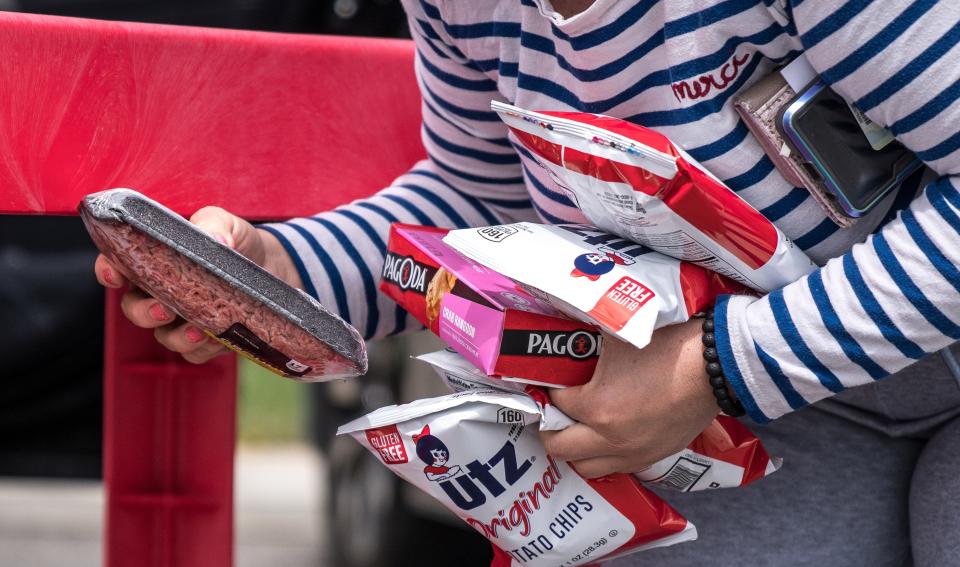'It didn't feel like $80 worth of food': Inflation is making it hard to make healthy food choices
AURORA, Colo. – Kevin Tave stretches a pot of spaghetti for three days of meals. Esmerelda Cortez gets eggs and bread from the food bank so she can afford laundry detergent at the store. Donnie Whitfield buys generic cereal instead of the Kellogg's he prefers.
Although unemployment continues dropping and wages are on the rise, all across the country, low-income people are struggling to put food on the table as skyrocketing inflation and high gas prices take a bigger bite of their already-small paychecks.
And experts say there's little reprieve in sight because of a combination of factors, including COVID-19-related supply chain disruptions, Russia's war on Ukraine, and corporate price-gouging. Further out, high fertilizer costs could compound the issues.
“You might be making $20 an hour, but what you’re paying out is so much more, in rent, in gas, in food, especially when you’re single," said Tave, 57, after collecting bread, eggs, meat and soda from a Salvation Army food pantry in the Denver suburbs. “I went to the grocery store and I came out with the bags in my hand and it cost me $80. And it didn’t feel like $80 worth of food."

Some politicians – especially President Joe Biden's conservative critics – blame the president for driving up food, labor and fuel prices in part by limiting new oil and gas drilling on federal lands, and by providing cash assistance to families during the pandemic.
Biden, who has blamed inflation largely on what he's dubbed "the Putin Price Hike," last week announced a $1 billion plan to increase independent meat and poultry processing capacity. Citing processing slowdowns that began during the pandemic, Biden said his plan would help eliminate supply-chain bottlenecks, help farmers earn more for their animals, and bring down consumer food prices.
Some liberal activists, including New York Rep. Alexandria Ocasio-Cortez, a Democrat, are pushing for Biden to use anti-monopoly laws to break up large food processors or corporations. Ocasio-Cortez this month pointed out that about 25% of all retail sales in the United States are made by either Amazon or Walmart. A handful of large corporations, which have reported record profits, also control much of the country's meat processing, she noted.
"Prices aren't being dictated by 'supply and demand,'" Ocasio-Cortez tweeted on April 6. "They're being dictated by CEOs."

Federal officials this month said inflation hit a 40-year high, and the consumer price index jumped 8.5% annually, the fastest pace since December 1981. Inflation now has reached new 40-year highs for five straight months, according to federal officials, and prices in March rose 1.2% from their February level, the sharpest monthly increase since September 2005.
For Americans with savings or high-paying jobs, the increases are easier to absorb. But for those who were already struggling, the rapid increases are forcing even tougher choices about what, when and how often to eat.
On average, Americans spend about 10% of their income on food, said Scott Brown, an agricultural economist at the University of Missouri. But the poorest Americans pay closer to 30%, he said, and those are the people with the least amount of flexibility to afford price hikes.
And while federal programs such as the Supplemental Nutrition Assistance Program provide aid to about 36 million people, those food assistance benefits totaling more than $60 billion are set by the federal government each June for the following year, meaning recipients today are getting benefits based on food prices last summer before prices began rising dramatically.
"We have inflation in everything. Does that affect everyone? Yes, but higher-income folks are able to manage without much difficulty," Brown said. "It's the poorest who are having the most difficulty."
Acknowledging that corporate profits for food conglomerates have been at record highs, Brown said he suspects that will change over the coming months as those companies are forced to offer higher wages to their workers, who are themselves paying more for food and fuel. He said 80% of the cost of food comes after it leaves a farmer's property, from the fuel needed to transport cows or corn, to the markup charged from turning a steer into prepackaged barbecue beef on a grocer's shelf.
Knowing that is little comfort to Frances Holmes, 59, of St. Louis. Holmes, a fast food worker, cares for both her granddaughter, 18, and her great-grandson, 2, stretching her $11-an-hour paycheck by shopping at discount store Aldi.
With tips, Holmes can bring home up to $15 an hour, and she's a member of the national “Fight for $15” campaign that wants the federal minimum wage raised to that level from its current $7.25, set in 2009. State minimum wages can be higher, and across the country, some fast food restaurants are offering closer to $19 an hour. Holmes said she's frustrated her employer so often cuts her hours or changes her shift, which means she earns less.
“It’s really hard. The prices of food are going up but the wages aren’t," Holmes said. "I just have to buy less than what I used to.”
Experts also worry the trickle-down effect of high food prices, especially for healthy, high quality food, risks setting more kids up for a lifetime of health problems, from obesity to diabetes.
Tens of millions of low-income Americans live in what the federal government calls "food deserts," or areas without convenient access to grocery stores, especially if they lack a car or live in a rural area. In some cases, experts say, parents working long hours outside the home choose food that is cheaper, less healthy and faster to put on the table.

“When families are food insecure and looking for calories, the first thing they do is pick out foods their kids will eat, that will fill them up, and those are not always the most nutrient dense foods," said Dr. Colleen Kraft, a pediatrician at Children's Hospital Los Angeles and a past president of the American Academy of Pediatrics. “These types of foods contribute to childhood obesity, to high cholesterol, even the precursors of diabetes in kids.”
Kraft counsels families she works with to try cooking at home more often, turning the process into an adventure for kids. She said she's often surprised how few children ever eat fresh fruits or vegetables, and teaching them to make careful but healthy choices now can pay dividends later, she said.
“If we have healthy children who grow up to become healthy teenagers and healthy adults then we have a country of people who can finish high school and college, who can show up to work, who can stay in healthy relationships and that helps keep us a country that is moving forward," she said.
Many of the country's lowest-income families have been receiving an extra boost in federal food assistance of about $100 per month under pandemic-related spending.

But some Republican governors have been withdrawing their states from those expanded programs, arguing that people should get jobs rather than depend on government handouts, especially at a time when so many businesses are hiring.
Experts say it's just not that simple for many people, from those struggling to recover from drug addictions to job skills mismatches, or families coping with COVID-19-related deaths. Even people with jobs are facing dramatic rent increases across the country, said Kenneth Hodder, national commander of The Salvation Army USA.
“People associate food insecurity with the beginning of the pandemic but I can tell you it remains a struggle for many people," Hodder said. "Whether or not you have a job, food is more expensive. In real terms, you’re still behind. It’s very tough for folks out there.”
Back at the Salvation Army food bank in Aurora, Whitfield hopes to someday switch back to Kellogg's cereal and splurge on lunch at Burger King once again. A retired veteran living on a fixed income, Whitfield, 71, said he's noticed high food prices most in eggs and meat, and switched from shopping at a local grocery store to buying generic at Walmart.
Cortez, 34, an out-of-work restaurant server, said she now comes to the food bank first, and then shops for whatever it didn't have. Salvation Army officials said they've seen that change nationally: Some people who once used food banks to supplement their shopping are now primarily depending on the donations to survive.
Tave, who works for a company that finds custom phone numbers for businesses, said he's hopeful he'll be able to get a new job or a raise to offset the higher food costs. He misses being able to afford fast food and buying organic food, which he considers healthier. And he's looking forward to the day when he can afford to buy whatever he wants.
“Leftovers are a big thing now. I’ll make a pot of spaghetti and make it last three days," he said. “I’ve been eating a lot of turkey meat. But I’d rather have steak.”

This article originally appeared on USA TODAY: Inflation means higher food prices, which impacts healthy eating

